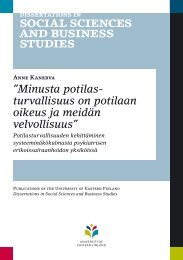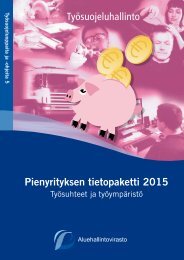urn_isbn_978-952-61-1770-6
urn_isbn_978-952-61-1770-6
urn_isbn_978-952-61-1770-6
- No tags were found...
You also want an ePaper? Increase the reach of your titles
YUMPU automatically turns print PDFs into web optimized ePapers that Google loves.
Data analysis and the drawing of conclusions from it are among the more contentiousaspects of qualitative research. 36 The most serious difficulty in the use ofqualitative data is that methods of analysis are not well formulated. 37 The analystfaced with a mass of qualitative data has very few guidelines to protect himselfor herself against self-delusion, let alone presenting unreliable or invalid conclusionsto the public. How can we be sure that a finding is not, in fact, wrong? 38This research has analysed the ECtHR’s argumentation in certain contexts and itseems clear that conclusions on justifiability and legitimacy may well be drawnfrom it. It is, naturally, inevitable that the author’s individual thumbprint will bedetectable both within the analysis and the conclusions drawn from it.Categorisation is an aspect of case law analysis, and involves, among otherthings, marking the appearances of cases in searches relating to certain themesor phrases. Researchers employing content analysis must take care to ensure thatthey have drawn upon a representative sample of documents. This thesis drawson 198 ECtHR cases: the ‘comparative argumentation’ article refers to 67 cases;the ‘social rights’ article to 87; and the ‘fourth instance’ article to 44. Researchersusually develop an index using labels in order to categorise the data. In this case,the marking has been done using pen and paper and all searched arguments (e.g.social rights arguments or comparative arguments) used in the cases have beenmarked in the categories to which they belong.The question that emerges is: how many cases is enough? While there are noset rules, at some point data saturation sets in. This means that there is a point atwhich no new information or themes are observed in the data. 39 This has provento be true for this study, since after a certain number of cases, the data started torepeat itself so that collecting more data would have added nothing significantto the picture.Besides using the study of legal cases approach, the more detailed ‘analysis ofargumentation’ approach has been used in the articles in order to examine argumentswith the help of different argumentation theories. Here the ‘rational argumentation’theory has been in the background for the analysis of the ECtHR’sargumentation. Legal arguments have been categorised from at least from thebeginning of the 1800s. Since then, many reclassifications have been introducedand the scope of the content has been extended, but the principle of categorisationhas remained. 40 In this study, the ECtHR’s legal arguments have been categorised36May 2001, at 158–163; Webley 2010, at 939.37Miles 1979, at 591.38Ibid.39For more on data saturation, see e.g. Richards 2009, at 144–145.40von Savigny (von Savigny 1840) has categorised legal arguments as text, precedent and legal science.In respect of temporary legal theory, see Huhn 2002; Huhn categorises legal arguments into text, intent,precedent, tradition and policy (Huhn 2008). Bobbit, on the other hand, speaks of modalities, whichare historical, textual, structural, doctrinal, ethical and prudential arguments (Bobbit 1991, at 12–13).MacCormick and Summers speak of linguistic, systemic, teleological, evaluative and trans-categoricalarguments (MacCormick – Summers 1991, at 512–516). See also MacCormick who identifies three maincategories of interpretative arguments (linguistic, systemic and teleological/deontological arguments(MacCormick 1995, at 472–477).19




